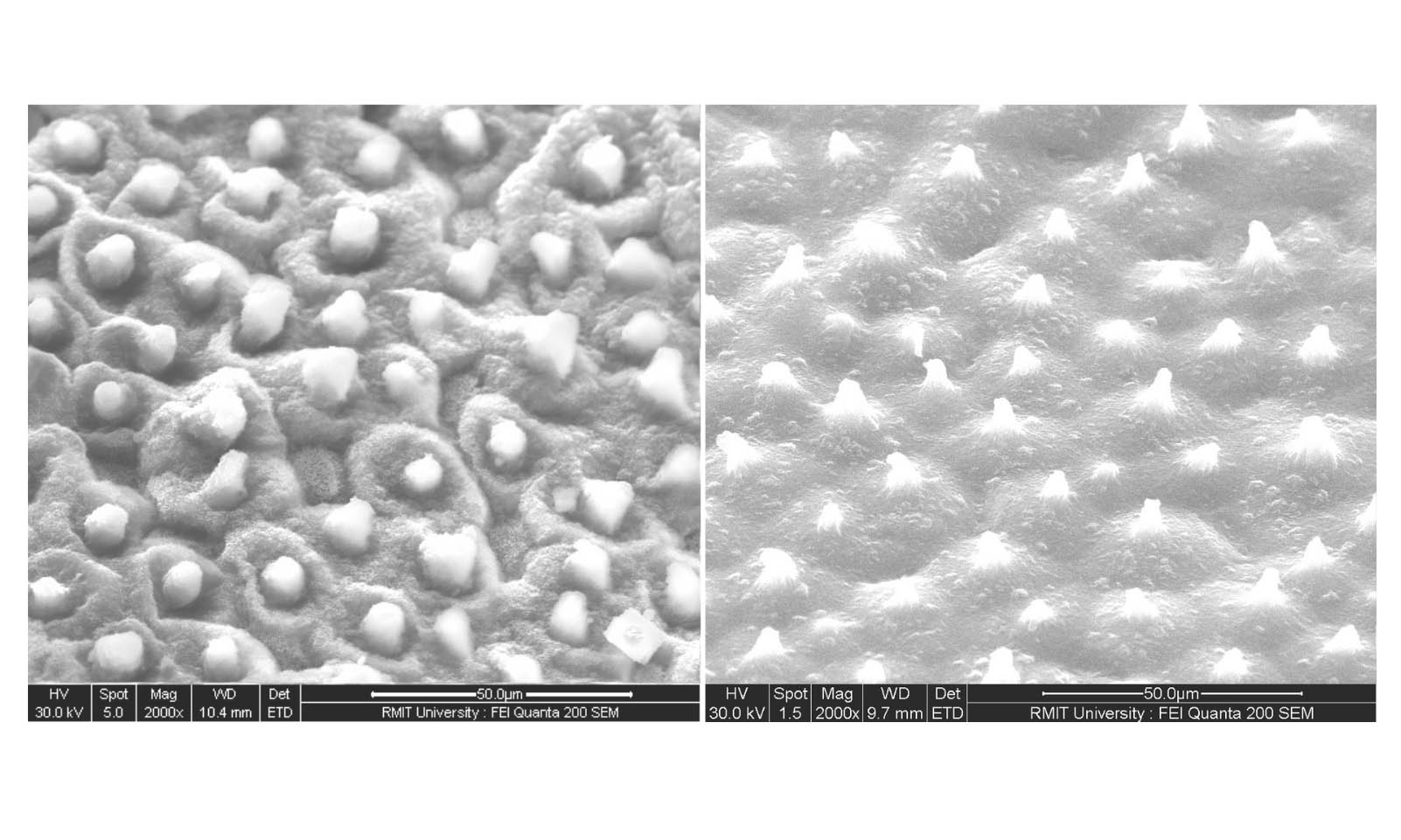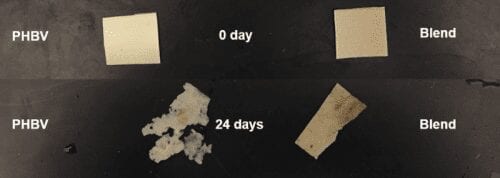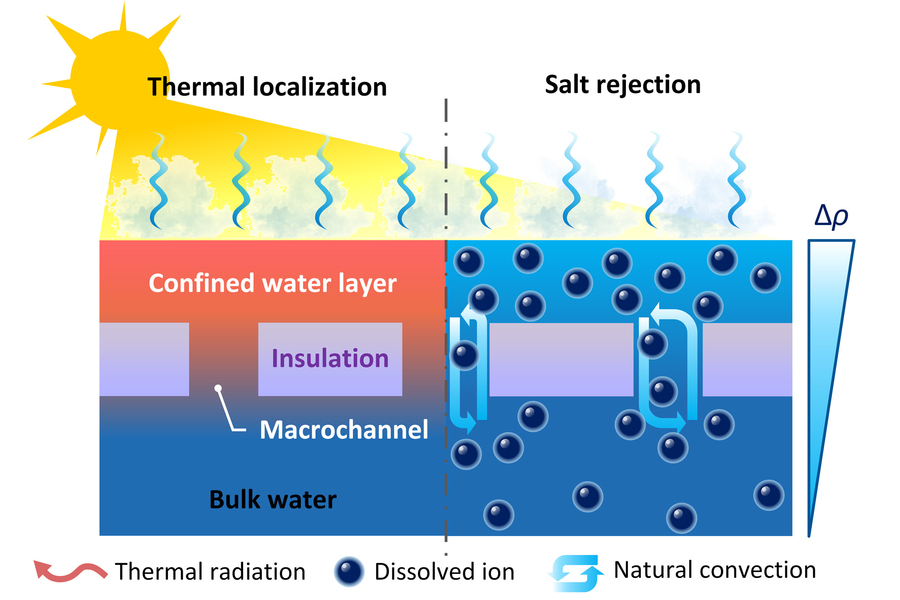
Magnified image showing the pillared structure of a lotus leaf (left) and the new bioplastic (right). Images magnified 2000 times.
Inspired by the always immaculate lotus leaf, researchers have developed a self-cleaning bioplastic that is sturdy, sustainable and compostable.
The innovative plastic developed at RMIT University repels liquids and dirt – just like a lotus leaf – then breaks down rapidly once in soil.
RMIT PhD researcher Mehran Ghasemlou, lead author of the study published in Science of the Total Environment, said the new bioplastic was ideal for fresh food and takeaway packaging.
“Plastic waste is one of our biggest environmental challenges but the alternatives we develop need to be both eco-friendly and cost-effective, to have a chance of widespread use,” Ghasemlou said.
“We designed this new bioplastic with large-scale fabrication in mind, ensuring it was simple to make and could easily be integrated with industrial manufacturing processes.”
Ghasemlou said nature was full of ingeniously-designed structures that could inspire researchers striving to develop new high-performance and multifunctional materials.
“We’ve replicated the phenomenally water-repellent structure of lotus leaves to deliver a unique type of bioplastic that precisely combines both strength and degradability,” he said.
The bioplastic is made from cheap and widely-available raw materials – starch and cellulose – to keep production costs low and support rapid biodegradability.
The fabrication process does not require heating or complicated equipment and would be simple to upscale to a roll-to-roll production line, Ghasemlou said.
Naturally compostable
While biodegradable plastics are a growing market, not all bioplastics are equal. Most biodegradable or compostable plastics require industrial processes and high temperatures to break them down.
The new bioplastic does not need industrial intervention to biodegrade, with trials showing it breaks down naturally and quickly in soil.
“There are big differences between plant-based materials – just because something is made from green ingredients doesn’t mean it will easily degrade,” Ghasemlou said.
“We carefully selected our raw materials for compostability and this is reflected in the results from our soil studies, where we can see our bioplastic rapidly breaks down simply with exposure to the bacteria and bugs in soil.
“Our ultimate aim is to deliver packaging that could be added to your backyard compost or thrown into a green bin alongside other organic waste, so that food waste can be composted together with the container it came in, to help prevent food contamination of recycling.”
Lotus-inspired structures
Lotus leaves are renowned for having some of the most water-repellent surfaces on earth and are almost impossible to get dirty.
The secret lies in the leaf’s surface structure, which is composed of tiny pillars topped with a waxy layer.
Any water that lands on the leaf remains a droplet, simply rolling off with the help of gravity or wind. The droplets sweep up dirt as they slide down, keeping the leaf clean.
To make their lotus-inspired material, the RMIT team of science and engineering researchers first synthetically engineered a plastic made of starch and cellulosic nanoparticles.
The surface of this bioplastic was imprinted with a pattern that mimics the structure of lotus leaves, then coated with a protective layer of PDMS, a silicon-based organic polymer.
Tests show the bioplastic not only repels liquids and dirt effectively, but also retains its self-cleaning properties after being scratched with abrasives and exposed to heat, acid and ethanol.
Corresponding author, Professor Benu Adhikari, said the design overcomes key challenges of starch-based materials.
“Starch is one of the most promising and versatile natural polymers, but it is relatively fragile and highly susceptible to moisture,” Adhikari said.
“Through our bio-inspired engineering that mimics the ‘lotus effect’, we have delivered a highly-effective starch-based biodegradable plastic.”
Ghasemlou is currently working with a bioplastic company, which is evaluating further development of these novel water repellant materials. The RMIT research team is keen to collaborate with other potential partners on commercial applications for the bioplastic.
Original Article: Lotus effect: Self-cleaning bioplastics repel liquid and dirt
More from: Royal Melbourne Institute of Technology
The Latest Updates from Bing News & Google News
Go deeper with Bing News on:
Self-cleaning bioplastics
- IIT Madras Carbon Zero Challenge announces top 25 teams with promising Sustainable Tech Innovation
Indian Institute of Technology Madras (IIT Madras) has announced the top 25 teams that form the fourth Cohort of the annual Carbon Zero Challenge, a pioneer pan-Indian competition to encourage ...
- This company just bioengineered a plant-bacteria combo to clean air better than an air purifier
That’s common knowledge, but given the amount of pollutants we produce, both outdoors and in our homes, plant life can only do so much to clean our air. However, the bioengineering firm Neoplants has ...
- YOUR TURN: Let's talk about plastic
I’m going to create a “compliment sandwich” to talk to plastic. A compliment sandwich is what good teachers use at school to help share news that may be hard to hear: compliment the pupil, say the ...
- The 20 Best Makeup Brands That Need to Be On Your Radar
What truly distinguishes Tower 28 Beauty is its genuine connection with its community. By valuing transparency and listening to customer feedback, the brand has earned trust and loyalty, positioning ...
Go deeper with Google Headlines on:
Self-cleaning bioplastics
[google_news title=”” keyword=”self-cleaning bioplastics” num_posts=”5″ blurb_length=”0″ show_thumb=”left”]
Go deeper with Bing News on:
Starch-based biodegradable plastic
- Can tapioca starch ‘bioplastics’ be an eco-friendly alternative to plastic bags?
(Bioplastics are made from ecofriendly materials like corn starch and vegetable fats and oil that decompose naturally as opposed to conventional plastic, which includes petroleum and natural gas ...
- Thermoplastic Starch (TPS) Market Upcoming Trends, Size, Key Players, Share, and Forecast to 2024 to 2032
Report Ocean recently published a research report titled “Thermoplastic Starch (TPS) Market” 2024 Forecast to 2032 Analysis by Market Trends.” This study delivers accurate economic projections, ...
- From Plastic to PLA: Mapping the Evolution of Biodegradable Cutlery Market
The market also exhibits a strong preference for plastic-based materials, which encompass bioplastics that are both biodegradable and compostable. In terms of raw material, segments such as wood ...
- German company makes biodegradable fruit and vegetable net packaging
Mesh Pack produces all types of packaging nets from plastic granulate but it is also focusing increasingly on sustainable alternatives. A new net based on corn starch has won several awards.
- Biodegradable breakthrough: Plastics that don’t create microplastics or make us sick
These tests confirmed the material's remarkable capacity to biodegrade, a stark contrast to traditional petroleum-based plastics ... starch, and lactic acid, form the basis of many biodegradable ...
Go deeper with Google Headlines on:
Starch-based biodegradable plastic
[google_news title=”” keyword=”starch-based biodegradable plastic” num_posts=”5″ blurb_length=”0″ show_thumb=”left”]




